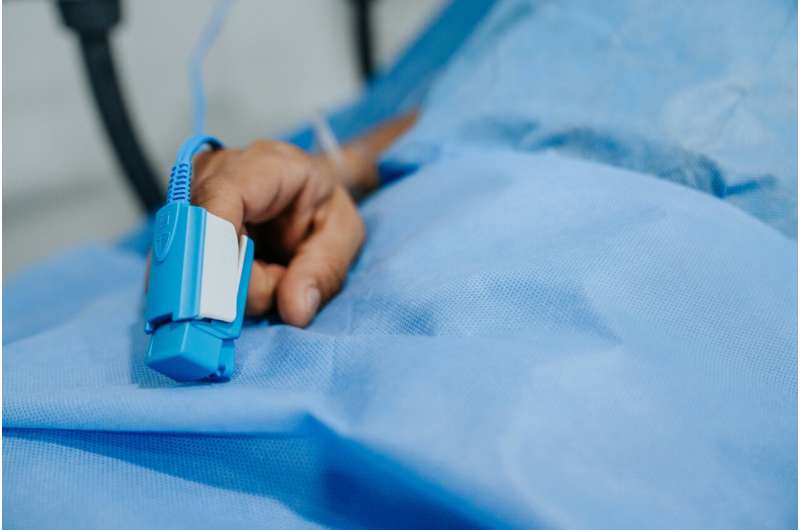This article has been reviewed according to Science X's editorial process and policies. Editors have highlighted the following attributes while ensuring the content's credibility:
fact-checked
trusted source
proofread
More efficient ways to monitor patient vital signs developed in NHS hospitals

Investigators have published the findings of a four-year study looking at how often hospital patients should have their vital signs monitored by staff.
The research was led by the University of Portsmouth in an effort to identify the ideal frequency of observations for keeping people safe while avoiding unnecessary extra work for busy staff.
Usually a person's blood pressure, temperature, pulse and other vital signs are checked every few hours and converted into a score.
The National Early Warning Score (NEWS) is a system in place in most UK hospitals to spot signs of deterioration among patients. It was designed in Portsmouth and issued by the Royal College of Physicians, and takes into account the previous observation. The more abnormal the patient's vital signs, the more frequent checks should be taken.
However, checking too often can be annoying for patients and interfere with rest and sleep, which are important to recovery. Nurses also need to plan their time well to look after patients who need care. Until now, there has been little evidence to suggest how long the time between observations should be.
The study, published in the Health and Social Care Delivery Research journal, was led by Professor Jim Briggs from the University of Portsmouth, and included colleagues from Oxford and Southampton universities and Portsmouth and Oxford hospitals.
Between 2018 and 2021, the team analyzed 400,000 anonymous patient records from general wards at two hospitals. Both use electronic systems to record the data and calculate an early warning score. They looked at the time between observations and how this affected the risk to the patient of any deterioration in their condition being missed.
Professor Briggs said, "Obviously, taking observations more frequently can reduce the risk, but that has to be offset by the extra nursing staff workload incurred and the disturbance to the patient—especially at night.
"Our work supports the approach of the current monitoring protocol, whereby patients' vital signs score guides how frequently they're monitored. The findings show that existing practice to observe higher-risk patients more often is objectively justified."
Part of the study also timed how long it takes nursing staff to record a patient's vital signs, finding it takes about five minutes on average. This information helped calculate how costs would change if patients' vital signs were taken more or less often.
The study found that patients with a low overall risk score could have their vital signs monitored less often, without being in danger of serious harm. The investigators say this could free up nursing time so that patients with a higher score could be monitored more often and this can be achieved without employing more staff.
"It is worth noting that important nurse–patient interactions take place during vital sign monitoring," explained Professor Briggs.
"So, reducing the frequency of monitoring might also reduce the opportunities for the nurse to notice other signs about the patient's condition and for the patient to ask questions about their care, for example. That's why regular interactions between patients and staff should not be eliminated completely under new monitoring processes."
The team explored several different scenarios with stakeholders—clinicians and patients—based on how 'risk' could be managed in different ways. They showed that risk could be kept within acceptable limits using fewer resources than currently.
Co-investigator Peter Griffiths, Professor of Health Services Research at the University of Southampton and a former clinical nurse, added, "Existing resources could be redeployed within a changed protocol to achieve better outcomes for some patients without compromising the safety of the rest."
Peter Watkinson, Professor of Intensive Care Medicine at Oxford University Hospitals NHS Foundation Trust and one of the clinicians involved in the project, commented, "Improvements to current recommendations for how often a patient in hospital should have vital signs taken could both free up time to provide other care and improve the speed with which a change in these vital signs is recognized.
"The findings from this important study provide valuable insights that can help us optimize patient monitoring protocols and improve the efficiency of nursing care in our hospitals," said Professor Anoop Chauhan, Chief Research Officer at Portsmouth Hospitals University and Isle of Wight NHS Trusts.
"By identifying opportunities to reduce unnecessary monitoring for lower-risk patients, we can free up nursing time to focus on those who need more frequent observations, ultimately enhancing patient safety."
More information: Jim Briggs et al, Safer and more efficient vital signs monitoring protocols to identify the deteriorating patients in the general hospital ward: an observational study, Health and Social Care Delivery Research (2024). DOI: 10.3310/HYTR4612

















